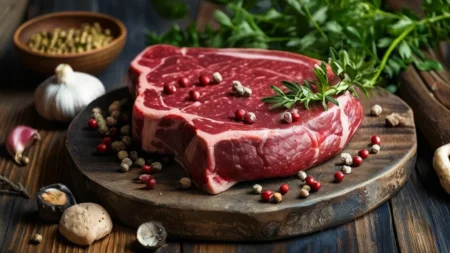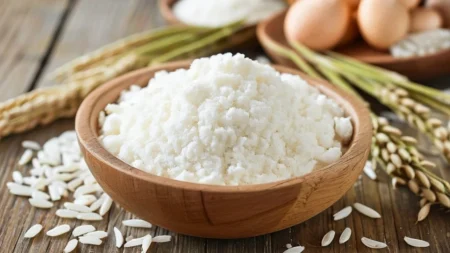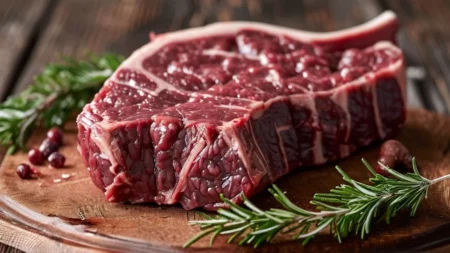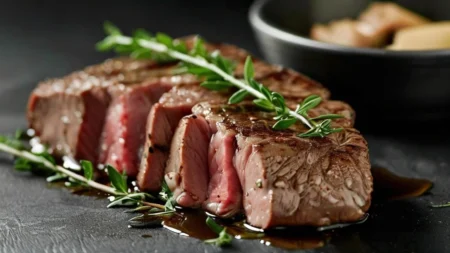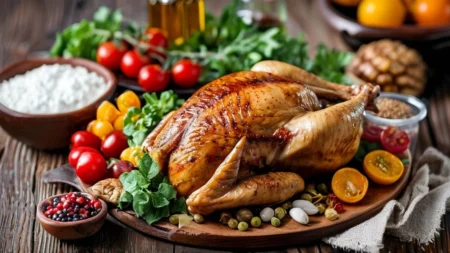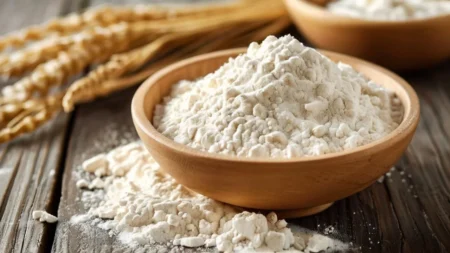Lamb: A Flavorful Source of Protein and Essential Nutrients
Key Takeaways:
- Lamb is a rich source of high-quality protein, essential vitamins, and minerals like iron and zinc.
- It offers a unique flavor, especially when grass-fed, making it a popular choice in Mediterranean and Middle Eastern cuisines.
- While lamb is higher in fat than other meats, it also contains healthy fats, including omega-3 fatty acids.
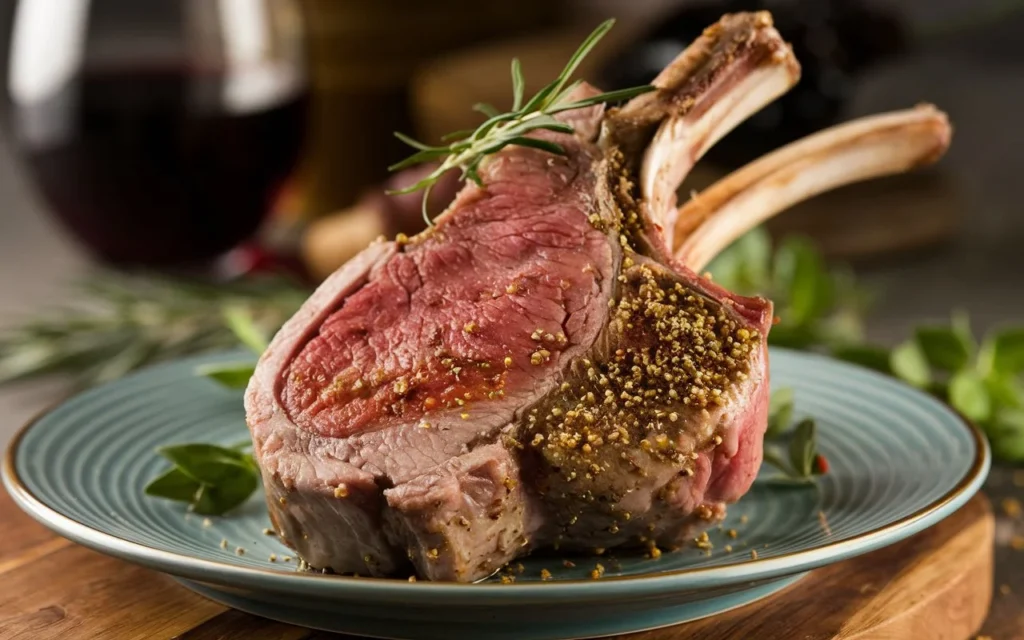
Nutritional Profile of Lamb
Lamb is not only packed with protein but also contains a range of vitamins and minerals. Here’s the nutritional breakdown for 100 grams (3.5 oz) of cooked lamb:
| Nutrient | Amount |
|---|---|
| Calories | 250 kcal |
| Protein | 25 grams |
| Total Fat | 16 grams |
| Saturated Fat | 7 grams |
| Iron | 2.1 mg (12% DV) |
| Zinc | 4.5 mg (41% DV) |
| Vitamin B12 | 2.7 mcg (113% DV) |
| Omega-3 Fatty Acids | 190 mg |
Rich in High-Quality Protein
Lamb offers about 25 grams of protein per serving, which is essential for muscle repair, tissue regeneration, and overall body function.
Health Benefits of Lamb
Though lamb is higher in fat than lean poultry or ground turkey, it provides a number of health benefits when eaten in moderation.
1. Supports Iron Levels
Lamb is a significant source of heme iron, the type of iron that’s more easily absorbed by the body compared to non-heme iron from plant sources. This helps in the production of red blood cells and prevention of anemia.
2. Boosts Immunity
Zinc found in lamb helps support a healthy immune system. It’s also crucial for wound healing and DNA synthesis.
3. Promotes Brain Health
Lamb is an excellent source of vitamin B12, which is vital for nerve function and the production of red blood cells. This vitamin also helps prevent cognitive decline.
Types of Lamb Cuts and Their Best Uses
Lamb comes in various cuts, each suited to different types of dishes. Here’s a guide to the most popular cuts and how to cook them:
| Cut | Description | Best Cooking Method |
|---|---|---|
| Lamb Chops | Tender, flavorful cuts from the rib | Grilling, Pan-searing |
| Lamb Shank | Lower part of the leg, tough but flavorful | Slow-cooking, Braising |
| Lamb Shoulder | A fatty, flavorful cut | Roasting, Slow-cooking |
| Lamb Leg | Leaner than other cuts | Roasting, Grilling |
Popular Lamb Recipes
Lamb’s distinct flavor makes it a key ingredient in many traditional dishes around the world. Here are some popular ways to enjoy lamb:
1. Roast Leg of Lamb
A traditional dish, roast leg of lamb is perfect for special occasions. The meat is tender and juicy, especially when marinated with garlic, rosemary, and olive oil.
2. Lamb Stew
Slow-cooked lamb stew is a hearty meal that’s popular in many cultures. The meat becomes tender over time, absorbing the flavors of vegetables, herbs, and spices.
3. Grilled Lamb Chops
Lamb chops are quick to cook and can be grilled with simple seasoning for a delicious meal. Serve them with a side of vegetables or salad for a balanced dinner.
Cooking Tips for Lamb
Cooking lamb can be tricky if you’re not familiar with the cuts and techniques. Here are some tips to ensure your lamb dishes turn out perfectly.
1. Cook to the Right Temperature
Lamb is best cooked to medium-rare (145°F) or medium (160°F) to maintain its juiciness. Use a meat thermometer to check the internal temperature to avoid overcooking.
2. Let It Rest
After cooking lamb, let it rest for about 10 minutes before slicing. This allows the juices to redistribute throughout the meat, ensuring a more flavorful and tender bite.
3. Marinate for Extra Flavor
Lamb’s unique flavor pairs well with herbs like rosemary, thyme, and oregano. Marinating the meat for a few hours before cooking can help enhance the flavors and tenderize the meat.
Lamb vs. Beef: A Nutritional Comparison
While both lamb and beef are popular red meats, they differ in nutritional value. Here’s how they compare:
| Nutrient | Lamb (100g) | Beef (100g) |
|---|---|---|
| Calories | 250 kcal | 217 kcal |
| Protein | 25 grams | 26 grams |
| Total Fat | 16 grams | 15 grams |
| Saturated Fat | 7 grams | 6 grams |
| Iron | 2.1 mg | 2.6 mg |
| Zinc | 4.5 mg | 6 mg |
Lamb contains slightly more fat and fewer calories than beef, but both are excellent sources of protein and essential minerals. For those looking to switch things up in their diet, lamb can be a flavorful alternative to beef.
Conclusion
Lamb is a nutrient-dense meat that offers numerous health benefits, from supporting iron levels to boosting immunity. Though higher in fat than some other meats, it contains healthy fats like omega-3s and is rich in protein, making it a valuable addition to a balanced diet. Whether you’re slow-cooking a lamb stew or grilling lamb chops, this versatile meat offers plenty of flavor and nutrition.
FAQ
Q: Is lamb healthier than beef?
A: Both lamb and beef offer high levels of protein and essential nutrients. However, lamb is slightly higher in fat, especially saturated fat, but it also contains more omega-3 fatty acids.
Q: Can I substitute lamb for beef in recipes?
A: Yes, lamb can be substituted for beef in most recipes. However, because lamb has a stronger flavor, it may change the taste of the dish slightly.
Q: Is lamb good for weight loss?
A: While lamb is nutritious, it is higher in calories and fat than lean meats like chicken or turkey. If you’re watching your calorie intake, it’s best to consume lamb in moderation.
Q: How can I reduce the fat content of lamb?
A: Choosing leaner cuts like the leg or trimming excess fat before cooking can help reduce the fat content. Grilling or broiling can also allow some of the fat to cook off.
Q: How long can I store cooked lamb in the fridge?
A: Cooked lamb can be stored in the refrigerator for up to 4 days when kept in an airtight container. For longer storage, it can be frozen for up to 6 months.





